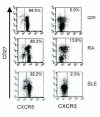Differential expression of chemokine receptors on peripheral blood B cells from patients with rheumatoid arthritis and systemic lupus erythematosus
- PMID: 16207316
- PMCID: PMC1257429
- DOI: 10.1186/ar1776
Differential expression of chemokine receptors on peripheral blood B cells from patients with rheumatoid arthritis and systemic lupus erythematosus
Abstract
Chemokines and their receptors are essential in the recruitment and positioning of lymphocytes. To address the question of B cell migration into the inflamed synovial tissue of patients with rheumatoid arthritis (RA), peripheral blood naive B cells, memory B cells and plasma cells were analyzed for cell surface expression of the chemokine receptors CXCR3, CXCR4, CXCR5, CCR5, CCR6, CCR7 and CCR9. For comparison, B cells in the peripheral blood of patients with the autoimmune disease systemic lupus erythematosus (SLE) or with the degenerative disease osteoarthritis (OA) were analyzed. Expression levels of chemokine receptors were measured by flow cytometry and were compared between the different patient groups and healthy individuals. The analysis of chemokine receptor expression showed that the majority of peripheral blood B cells is positive for CXCR3, CXCR4, CXCR5, CCR6 and CCR7. Whereas a small fraction of B cells were positive for CCR5, practically no expression of CCR9 was found. In comparison with healthy individuals, in patients with RA a significant fraction of B cells showed a decreased expression of CXCR5 and CCR6 and increased levels of CXCR3. The downregulation of CXCR5 correlated with an upregulation of CXCR3. In patients with SLE, significant changes in CXCR5 expression were seen. The functionality of the chemokine receptors CXCR3 and CXCR4 was demonstrated by transmigration assays with the chemokines CXCL10 and CXCL12, respectively. Our results suggest that chronic inflammation leads to modulation of chemokine receptor expression on peripheral blood B cells. However, differences between patients with RA and patients with SLE point toward a disease-specific regulation of receptor expression. These differences may influence the migrational behavior of B cells.
Figures











References
Publication types
MeSH terms
Substances
LinkOut - more resources
Full Text Sources
Other Literature Sources
Medical

